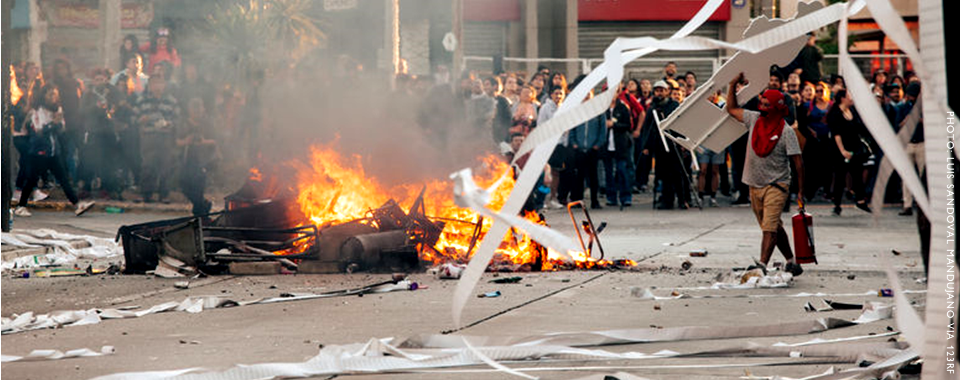BY CHARLES FIERTZ
On October 7, in the Santiago metro, a group of students began jumping turnstiles to protest a four percent rise in peak-time fares announced the day before. This was the second increase in fares for public transportation, which were already more than twice as expensive as those in neighboring Buenos Aires or Lima. While the Economy Minister blithely suggested workers wake up earlier to avoid the increase, the protest grew rapidly. On October 18, the day after an interview was published in which President Sebastián Piñera described Chile as an oasis, the capital Santiago was in flames. For the first time since the fall of Chile’s former dictator General Augusto Pinochet, a state of emergency was declared due to political unrest. This did little to quell the unrest and, seven days later, around 20 percent of Santiago’s population took to the streets, with more protests occurring in other cities. These protests were the largest since Chile’s return to democracy, surpassing the records set by the May 2011 protests against inequality in the education sector during Piñera’s previous term. It is against the backdrop of this social unrest that Chile rates as the most worsened country on the 2020 Fragile States Index (FSI).
Piñera’s initial response to the protests attempted to combine both carrot and stick. Along with reversing both the fare increase and a recent hike in electricity prices, Piñera also announced a series of measures aimed at helping the poor and middle class cope with the rising cost of living, including increases in government-subsidized pensions and the minimum wage, as well lowering the price of medicine for the elderly. However, Piñera also declared the country “at war with a powerful and uncompromising enemy” and deployed the army and military police into the streets of Santiago. By the end of the year, over 30,000 people had been arrested and the National Human Rights Institute leveled nearly a thousand criminal complaints – including of torture, rape, and homicide – against the security forces.

Piñera’s description of Chile as an oasis – while spectacularly poorly timed – matched the widespread external perception of the country’s economy. Since 1990, Chile has gone from being one of the poorest countries in South America to being the richest,1 poverty has fallen from 38.6 percent to 7.8 percent, and the middle class has grown to become a majority of the population. However, these successes have masked growing structural problems. According to the World Inequality Database, by 2015 the share of income captured by the 1 percent had grown to levels not seen since before the turn of the century while between 2006 and 2017, the income of the top 10 percent of households grew from 30 times that of the bottom 10% to 40 times. The median salary is below the poverty line for a family of four and just 20 percent of the population earns more than they spend on food, transport, housing, and basic services. Unemployment has been rising since 2015; a push to expand privatized tertiary education has left a legacy of high student debt while unemployment for those with advanced education has climbed above that of those with a basic education.
While most Chileans have been struggling with high prices and low wages, the elites have worked to further tilt the playing field in their direction. The 543 wealthiest households in Chile, a group which includes Piñera in its highest echelons, receive ten percent of the total income, often from a single company dominating key markets, such as beer, tobacco, and domestic air travel. In other markets companies colluded to raise prices, but this went unpunished because it was not defined as a crime under Chile’s legal system. This situation has increasingly corrupted the political system. In recent years, revelations have emerged of companies bribing lawmakers in direct quid pro quos and the illegal funding of political campaigns on the both the left and right, but punishments have been few and far between. Even the police force was hit by a major scandal in 2017, with over 100 people implicated in a scheme to redirect as much as 25 billion Chilean pesos from the institution to the personal accounts of individual officers.
Support for the protests as a necessary corrective against this inequality and corruption was widespread; most polls showed that three-quarters of Chileans supported the protest movement and with an even higher number in favor of their demand for constitutional reforms.
Chile’s worsening on the 2020 FSI is a step backwards from a previously improving overall trend that saw the country do better year-on-year in six of the last seven years. It is notable that indicators including Uneven Economic Development and Security Apparatus – two highly relevant indicators for the current situation – were steadily worsening despite Chile’s overall improving trend, wherein its total FSI score improved by 3.4 points between 2012 and 2019. The Chilean example again demonstrates the importance of considering individual indicator trends as much as a country’s overall trend. Further, Chile further demonstrates that long-term improvement is rarely linear, and improvements in some aspects – particularly economic development – can sometimes obscure underlying brittleness or vulnerabilities.
A referendum on whether to revise the constitution is scheduled for April 2020, but with political parties having an even lower approval rating than Piñera, it is unclear how Chile’s political institutions will manage this popular anger. In the best case, this will prove to be an opportunity to institute some sorely needed structural reforms that will help the country to be a model for the rest of the region. In the worst, the intransigence of the elites could set the stage for the emergence of a demagogue like Brazilian President Jair Bolsonaro or former Venezuelan President Hugo Chavez.
Endnotes
1. As measured by GDP per capita, PPP.
